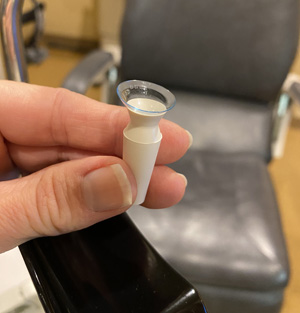
People with irregularly shaped corneas ― where the shape of the eye keeps them from focusing well ― and those who have paralyzed facial muscles and can’t blink are all candidates for scleral lenses, rigid, gas-permeable lenses designed to cover the entire cornea.
Vanderbilt Eye Institute is one of a handful of places in Nashville that can fit patients for the lenses that cover the sclera (white of the eye). Patients come from all over the Southeast to have them fitted.
The main benefit of scleral lenses is that they can be designed to accommodate any degree of corneal steepness or irregularity. If the cornea doesn’t have a perfect dome shape, vision will be poor through both glasses and traditional contact lenses. They are also beneficial for those with severely dry eyes. Scleral lenses allow oxygen to pass through to the cornea and can correct conditions that regular lenses can’t.
They are more comfortable than standard contact lenses because the conjunctival tissue on which scleral lenses rest is less sensitive than corneal tissue.
“The edges of the lenses tuck under the eyelid so a person can’t feel the edges as much as they do with standard contact lenses,” said Dora Mathe, MS, OD, associate professor of Clinical Ophthalmology and Visual Sciences. “They are not that common, but they’re gaining in popularity because of all of the benefits,” she said.
The space between the cornea and the back of the scleral lens acts as a fluid reservoir filled with preservative-free saline, “almost like submerging the cornea in a fishbowl,” she said. This can provide relief for people who have damage to the surface areas of the eye ― someone without an eyelid, for example ― and can help the ocular surface to heal. “Their cornea is safe because it’s under this liquid reservoir, almost like a liquid Band-Aid,” she said.
The sclera has considerably fewer nerve endings than the cornea, meaning less sensitivity and a very comfortable contact lens, Mathe said. “They offer protection, dryness relief, and improve optics for diseases. But you don’t have to be sick to enjoy the benefits from them. We have lots of routine dry-eye patients who are intolerant to soft contact lenses, and they do very well.”
Patients place the daily lenses in the morning and take them out at bedtime. Although they cost more than daily disposable lenses, and some insurance companies won’t pay, patients can wear them for about a year before needing to replace. The cost ends up being about the same as a year’s supply of daily disposable lenses, Mathe said.
Scleral lenses take more time to fit than standard contact lenses. The optometrist who is fitting the lens requires special training, and the fitting process is time consuming, requiring several visits.
“When you fit regular contact lenses, they sit right on top of the cornea. We can match the shape of the cornea really well and have good ways of figuring out the right size,” Mathe said. “For scleral lenses, since we don’t have a good way of imaging the white part of the eye, which has lumps and bumps and is egg-shaped, it takes experience in fitting them, and they take more time to fit.”
She said many people who wear bifocals might also need to wear reading glasses in addition to the scleral lenses since it’s tricky to provide both distance and near vision in a contact lens.
In 2024, VEI will begin using a special type of scleral lens called Eyeprint Pro. The eye is numbed, a mold is squirted into the eye, and an impression is made of patient’s sclera so that the patient receives a more customized lens that matches the contours of the eye.
“These are more for patients who have scars and lumps that make it so standard scleral lenses are just not possible to fit,” Mathe said.












